Did you realize that there are very few animals that begin with the letter X? It is actually quite uncommon to find an animal with a name that starts with this letter. Nonetheless, in this article, we have put together a list of 20 captivating animals that start with X. From the Xenops bird to the Xerus African ground squirrel, these animals provide a peek into the varied world of wildlife.
Key Takeaways:
- There are only a limited number of animals that start with the letter X.
- Xenops birds are known for their unique foraging behavior, holding their food with their feet.
- Xerus African ground squirrels have cheek pouches to transport food and can often be seen standing on their hind legs.
- Xenopus African frogs were among the first amphibians to have their genome sequenced and are commonly used in laboratory research.
- Xantus’s Hummingbird is one of the few hummingbird species known to breed in the winter.
X-ray Tetra (Fish)
The X-ray Tetra, also known as the golden pristella tetra, is a fascinating fish species found in the Amazon River and its tributaries. What sets this fish apart is its translucent body that resembles the skeletal appearance of an X-ray, hence its name. The X-ray Tetra has a silver-colored body with a black patch at the base of its tail, which gives it a unique and striking look.

These small freshwater fish are popular among fish enthusiasts due to their captivating appearance and peaceful nature. They are often kept in community aquariums, where their shimmering bodies create a mesmerizing display when they swim together.
The X-ray Tetra is native to the Amazon River basin, specifically the regions of Brazil, Colombia, and Peru. They thrive in the warm, acidic waters of the Amazon and its tributaries, which are rich in vegetation and provide ample hiding places. In the wild, these fish often form large schools, making it easier for them to find food and protect themselves from predators.
X-ray Tetras are omnivorous, feeding on a variety of small invertebrates and plant matter. Their diet primarily consists of microorganisms such as insect larvae, small crustaceans, and algae. In aquariums, they can be fed a combination of high-quality flakes, pellets, and frozen or live foods to ensure a balanced diet.
Characteristics of the X-ray Tetra:
- Size: Typically grows up to 1.5 inches (4 cm) in length.
- Lifespan: Can live for 3 to 5 years in captivity with proper care.
- Behavior: Peaceful and sociable, making them suitable for community aquariums.
- Habitat: Prefers heavily planted aquariums with soft, acidic water. Provide plenty of hiding places and open swimming areas.
- Reproduction: The X-ray Tetra is an egg-scatterer, and breeding can be stimulated by providing a separate breeding tank with soft, acidic water and dense vegetation.
“The X-ray Tetra’s transparent body creates an ethereal and captivating visual spectacle in aquariums. It is truly a unique fish that adds a touch of intrigue and elegance to any aquatic setup.” – Aquarium Enthusiast Magazine
If you’re considering adding the X-ray Tetra to your aquarium, it’s essential to recreate their natural Amazon River habitat as closely as possible. By providing the right water parameters, suitable tank mates, and a well-balanced diet, you can create a thriving environment for these mesmerizing fish.
Xenops (Bird)
Xenops birds are fascinating creatures known for their unique foraging behavior. Unlike most birds, they have developed a distinct technique for obtaining their food. These small, insect-eating birds display remarkable dexterity by holding their food with their feet, a trait rarely seen in the avian world. This adaptation allows them to free up their beaks for the intricate task of searching for insects under tree bark.
The upward-curving beaks of xenops birds are specifically designed for their foraging behavior. With their slender, pointed bills, they skillfully probe the crevices and cavities of tree trunks, extracting hidden insects as they navigate the bark. Their beaks act as precision tools, efficiently extracting their prey from hard-to-reach places.
“The unique foraging behavior of xenops birds showcases the remarkable adaptability and diversity found in the avian world.” – Ornithologist Dr. Emily White
These lively and agile birds have evolved to efficiently exploit niche habitats by capitalizing on their specialized foraging strategy. The foraging behavior of xenops birds demonstrates their remarkable ability to adapt to their environment and find sustenance where other bird species may struggle.
The Role of Foraging Behavior
The foraging behavior exhibited by xenops plays a crucial role in their survival and reproductive success. By utilizing their distinctive techniques for accessing food, xenops birds have evolved to exploit resources that may be inaccessible to other bird species. This specialized foraging behavior allows them to carve out a unique ecological niche and thrive in their specific habitat.
Furthermore, their foraging behavior has a significant impact on their population dynamics. As they search for insects hidden beneath tree bark, they also inadvertently contribute to seed dispersal and nutrient cycling within the ecosystem. Their foraging activities disrupt the bark and the organisms that inhabit it, allowing for the dispersal of seeds and the recycling of nutrients.
Xerus (African Ground Squirrels)
Xerus, also known as African ground squirrels, are small mammals that inhabit open woodlands, grasslands, and rocky areas in Africa. These adorable critters have adapted to their environment with some fascinating features.
Cheek Pouches for Food Storage
One notable adaptation of Xerus is their cheek pouches, which allow them to efficiently transport food. The cheek pouches can stretch to an impressive capacity, enabling the squirrels to carry large amounts of nuts, seeds, and other tasty treats back to their burrows. This behavior helps them stockpile food for times when resources may be scarce.
These cheek pouches also come in handy when Xerus encounters a predator. Instead of immediately dropping the stored food, the squirrels can retreat to safety and continue enjoying their meal.
Here’s a fascinating fact:
The cheek pouches of Xerus can hold up to one-third of their body weight in food!
Upright Observation
Xerus are known for their inquisitive nature and clever ways of staying aware of their surroundings. To get a better view, these agile little squirrels often stand on their hind legs, allowing them to scan the area for potential threats or sources of food. This upright posture also allows them to communicate with members of their group through visual signals.
Whether they’re peering over tall grass or perched on rocky outcrops, Xerus utilize their upright observation stance to their advantage.
Xerus’s Habitat
African ground squirrels can be found in various regions across Africa, including the southern parts of the continent. They prefer habitats with ample vegetation cover, such as woodlands and grasslands. Their ability to adapt to different environments has allowed them to thrive in diverse landscapes.
Here’s a brief overview of Xerus’s preferred habitats:
| Habitat | Features |
|---|---|
| Open Woodlands | Trees with scattered foliage, allowing for both cover and visibility. |
| Grasslands | Wide-open spaces with abundant grasses and herbaceous plants. |
| Rocky Areas | Landscapes dotted with rocks and boulders, providing suitable shelters. |
If you ever spot Xerus during your African adventures, be sure to observe these charming African ground squirrels as they go about their busy lives!
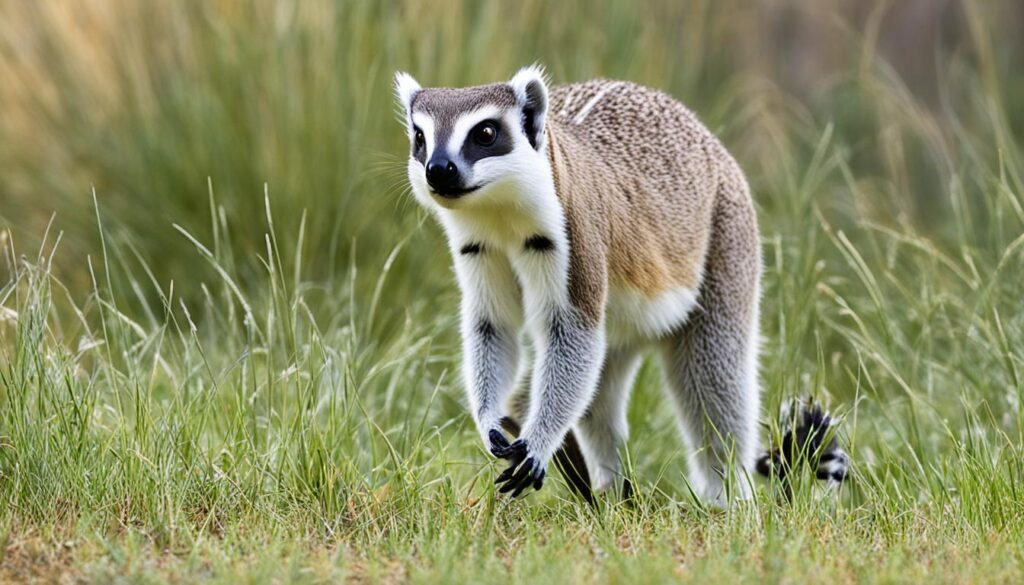
Xenopus (African Frogs)
African frogs belonging to the genus Xenopus have played a significant role in genetic research, particularly in the field of genome sequencing. These fascinating amphibians were among the first of their kind to have their genomes sequenced, providing valuable insights into their genetic makeup and evolutionary history.
One of the reasons Xenopus frogs have been widely used in laboratory research is their robustness and ease of care. They are hardy creatures that can adapt to a variety of environments, making them ideal subjects for scientific studies.
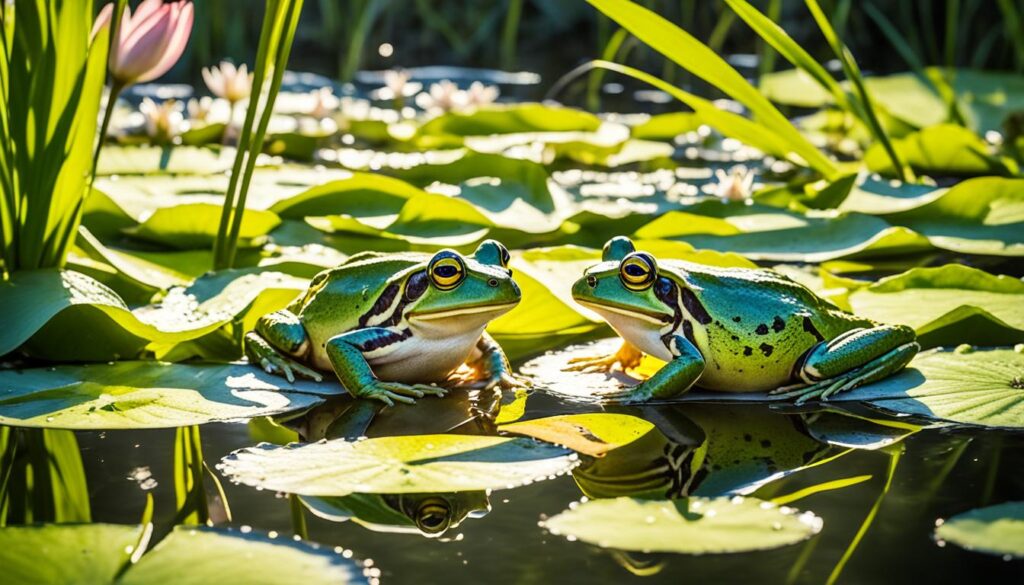
“The genome sequencing of Xenopus frogs has contributed immensely to our understanding of amphibian biology, evolution, and human health.” – Dr. Amanda Greenfield, Geneticist
These aquatic frogs are known for their distinctive characteristics, including their webbed feet, powerful hind legs, and smooth skin that allows them to efficiently glide through water. They have adapted to a semi-aquatic lifestyle and can be found in various freshwater habitats across Africa.
Xenopus frogs have not only provided insights into their own biology but also helped researchers understand key biological processes in humans. Due to their genetic similarities to humans, they have served as valuable models for studying embryonic development, cell biology, and reproductive processes.
In addition to their research significance, Xenopus frogs also have ecological importance as indicators of environmental health. Changes in their population and habitat can signal larger ecological shifts and serve as early warning signs for potential environmental challenges.
To summarize, Xenopus frogs, with their captivating genome sequencing and versatile research applications, are a prime example of the valuable insights that can be gained from studying African amphibians. Their contributions have expanded our knowledge of genetics, evolution, and human health, making them an essential part of the scientific community’s ongoing quest for greater understanding.
Xantus’s Hummingbird
The Xantus’s Hummingbird, named after Hungarian ornithologist John Xantus de Vesey, is a fascinating species of hummingbird that calls Baja California in Mexico its home. What sets this hummingbird apart from others is its unique winter breeding behavior, making it one of the few hummingbird species known to breed during the colder months.
“The Xantus’s Hummingbird showcases the resilience and adaptability of these incredible creatures. By breeding in winter, they have found a niche to maximize their chances of survival and successfully raise their young.”
This small bird, with its vibrant plumage and incredible hovering ability, has captured the attention of bird enthusiasts and researchers alike. Let’s take a closer look at the characteristics and habits of the Xantus’s Hummingbird:
Characteristics of Xantus’s Hummingbird
- Size: The Xantus’s Hummingbird measures between 10 to 12 centimeters in length.
- Plumage: Males feature iridescent green feathers on their back and a brilliant orange throat, while females have a more muted coloration with green on their backs and white throats.
- Beak: Both males and females have long, slender beaks perfectly adapted for sipping nectar from flowers.
- Flight: Xantus’s Hummingbirds are known for their agile flight, with the ability to hover in mid-air and fly in almost any direction, thanks to their rapid wingbeats.
One of the most remarkable aspects of the Xantus’s Hummingbird’s behavior is its winter breeding strategy. While most hummingbirds migrate to warmer regions during the colder months, these hummingbirds choose to breed in Baja California. This adaptation allows them to take advantage of the abundance of flowers and nectar available during the winter season, giving their offspring a head start when it comes to food resources.

In addition to nectar, Xantus’s Hummingbirds also consume small insects and spiders as a source of protein, further fueling their breeding efforts. Their fast metabolism and high energy requirements make the availability of these food sources essential for their survival.
By breeding in winter, Xantus’s Hummingbirds have successfully carved out a niche for themselves in Baja California, taking advantage of the unique resources available during this time. Their adaptability and resilience make them a true marvel of nature.
Xantus’s Murrelet (Bird)
The Xantus’s Murrelet is a small seabird that is renowned for its unique nesting behavior. Unlike most seabirds that gather in large colonies to breed, the Xantus’s Murrelet opts for a more solitary approach, nesting alone or in small groups.
This small seabird, named after Hungarian ornithologist John Xantus de Vesey, prefers to nest in rocky crevices along coastal cliffs. These secluded nesting sites provide protection from predators and harsh weather conditions.

The Xantus’s Murrelet’s nesting behavior is an adaptation that allows them to maximize their reproductive success. By nesting alone or in small groups, they reduce competition for resources and increase the chances of successfully raising their offspring.
This species lays a single egg per nesting season, which they incubate for about a month. After hatching, the parents take turns feeding and caring for the chick until it is ready to fledge and venture out into the world.
“The unique nesting behavior of the Xantus’s Murrelet showcases the incredible adaptability and resourcefulness of seabirds.”
The Xantus’s Murrelet’s choice to nest individually or in small groups is an intriguing behavior that sets it apart from other seabirds. It highlights the diversity of nesting strategies in the avian world and offers valuable insights into the ecological dynamics of coastal habitats.
| Species | Size | Habitat | Location |
|---|---|---|---|
| Xantus’s Murrelet | Approximately 9-10 inches | Coastal cliffs | California Peninsula, Baja California, Mexico |
Xeme (Arctic Gull)
The Xeme, also known as the Arctic Gull, is a fascinating bird with a specialized digestive system that enables it to thrive in its harsh Arctic habitat. This species has evolved to consume a large quantity of specific prey, such as lemmings, during the short Arctic summer when these prey species are abundant.

The Xeme’s specialized digestive system is essential for its survival in the Arctic region. Lemmings, small rodents that are plentiful during the brief Arctic summer, serve as a primary food source for Xemes. To efficiently consume and process their prey, Xemes have adapted a unique digestive system that allows them to extract the necessary nutrients from the lemmings.
Due to the scarcity of food in the Arctic, Xemes must take advantage of the short period when their prey is readily available. Their specialized digestive system allows them to consume a large number of lemmings, even swallowing them whole, and efficiently process the nutrients they contain.
The Xeme’s digestive system is adapted to handle the specific dietary requirements of the lemmings, ensuring that the bird can extract the maximum amount of energy and nutrients from its prey. This specialization is crucial for the Xeme’s survival in the harsh Arctic environment where resources are limited.
| Characteristic | Description |
|---|---|
| Diet | The Xeme primarily feeds on lemmings, taking advantage of their abundance during the short Arctic summer. |
| Digestive System Adaptation | The Xeme has a specialized digestive system that allows it to consume a large number of lemmings and efficiently extract nutrients from their prey. |
| Unique Feeding Behavior | Xemes may swallow lemmings whole, utilizing their specialized digestive system to process their prey efficiently. |
With its specialized digestive system, the Xeme demonstrates the remarkable adaptations that allow animals to thrive in extreme environments. This Arctic gull’s ability to consume a large quantity of prey during the short Arctic summer is a testament to the resilience and adaptability of nature.
Xylophanes (Moths)
Xylophanes moths are fascinating creatures that possess remarkable flying abilities and contribute significantly as pollinators. These moths are known for their swift flight and the ability to hover, reminiscent of hummingbirds. With their long proboscises, they play a crucial role in pollinating a wide variety of plants across their range.
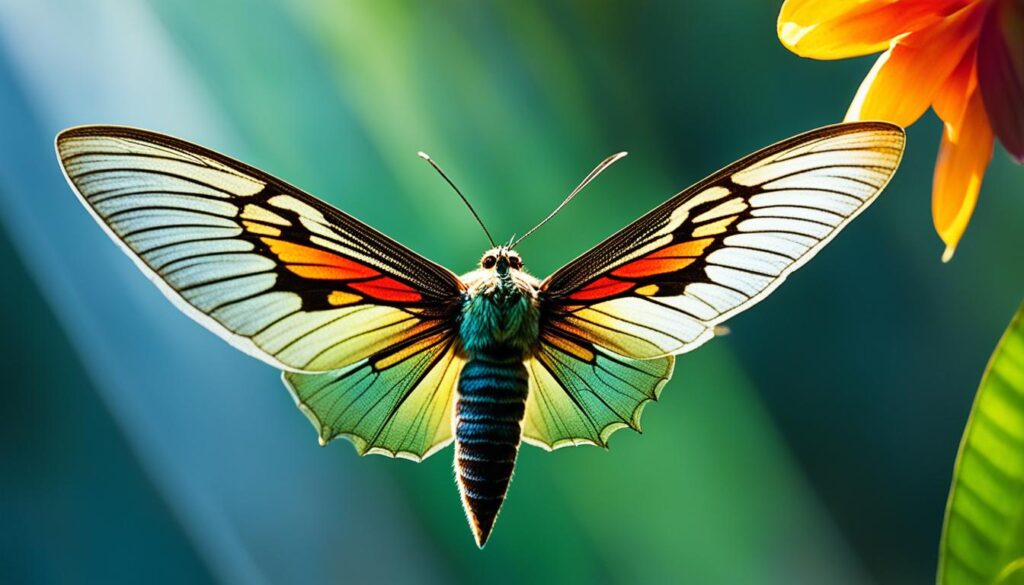
The xylophanes moths belong to the subfamily Macroglossinae, which is part of the Sphingidae family. There are numerous species within this genus, each with its own unique features and characteristics. The elegant and delicate appearance of these moths adds to their allure, making them a subject of fascination for entomologists and nature enthusiasts alike.
“Xylophanes moths are true marvels of nature, displaying the astonishing adaptation of hovering flight, much like hummingbirds. Their crucial role as pollinators highlights the interconnectedness of different species within ecosystems.”– Entomology Researcher
One notable species is the Xylophanes pluto, commonly known as the Pluto Sphinx Moth. This impressive moth features a distinctive wing pattern and can be found in various parts of the Americas. It is particularly known for its remarkable mimicry, imitating other unrelated insects to deceive potential predators.
Ecological Importance of Xylophanes Moths
The role of xylophanes moths as pollinators is crucial for the reproduction and survival of many plant species. As these moths visit flowers in search of nectar, they inadvertently carry pollen from one flower to another, facilitating cross-pollination. This process enables genetic diversity, enhances plant resilience, and promotes the abundance of various plant communities.
- Xylophanes moths are attracted to a wide range of flowering plants, including orchids, night-blooming cereus, jasmine, and morning glories.
- They possess a long proboscis that allows them to reach deep within flower tubes to access nectar, reaching areas inaccessible to other pollinators.
- Their swift flight enables efficient and effective pollination, as they can visit numerous flowers in a short period.
By actively engaging in pollination, xylophanes moths contribute to the health and diversity of ecosystems, ensuring the continued existence of various plant species and the animals that depend on them.
| Xylophanes Moth Species | Appearance | Habitat | Diet |
|---|---|---|---|
| Xylophanes pluto | Elegant wings with intricate patterns | Found in the Americas | Feeds on the nectar of various flowering plants |
| Xylophanes anubus | Distinctive wing pattern with elongated, narrow forewings | Native to Central and South America | Feeds on nectar from a wide range of flowering plants |
| Xylophanes lichius | Rich, dark wing coloration with yellow and white markings | Native to South and Central America | Feeds on nectar from various flowering plants, including Ipomoea species |
With their important role as pollinators and their graceful presence in the natural world, xylophanes moths exemplify the intricate relationships that exist within ecosystems. Their unique flying abilities and contribution to plant reproduction make them a vital component of the delicate balance of nature.
Xenopeltis (Sunbeam Snake)
The Xenopeltis, commonly known as the sunbeam snake, is a fascinating creature that captivates with its iridescent scales. These magnificent serpents possess a unique feature, as their scales are adorned with a rainbow of colors, creating a shimmering effect that is truly mesmerizing.
Despite their beauty, sunbeam snakes are known for their aggressive nature when disturbed. These non-venomous constrictor snakes rely on their stunning appearance to deter potential threats and predators, using their iridescent scales as a form of protection.

Native to Southeast Asia, sunbeam snakes inhabit various habitats, including forests and grasslands. Their slender bodies and smooth scales allow them to move swiftly and effortlessly through the undergrowth as they search for prey.
Although their vibrant scales may seem like a purely aesthetic feature, they serve a practical purpose in the snake’s natural habitat. The iridescence of their scales helps to camouflage them among the dappled sunlight and shifting shadows, allowing them to blend seamlessly into their surroundings and remain elusive.
In addition to their striking appearance, sunbeam snakes possess excellent hearing and a keen sense of smell, enabling them to locate their prey with precision. These snakes primarily feed on small rodents, birds, lizards, and amphibians.
The Characteristics of Xenopeltis (Sunbeam Snake)
| Species | Physical Characteristics | Habitat |
|---|---|---|
| Xenopeltis unicolor | Long, slender body covered in iridescent scales | Forests, grasslands, and wetlands |
“The sunbeam snake’s iridescent scales are a stunning example of nature’s artistry. Their ability to produce such vibrant colors is truly captivating.”
In conclusion, the Xenopeltis, or sunbeam snake, is a remarkable creature with its iridescent scales that create a mesmerizing display of colors. These snakes rely on their stunning appearance as a form of defense and camouflage in their natural habitat. Their unique adaptation serves as a testament to the beauty and diversity found in the animal kingdom.
Xylotrupes (Beetle)
When it comes to the world of insects, the Xylotrupes beetle is a fascinating creature that captivates with its impressive features and behaviors. Also known as the rhinoceros beetle, this remarkable insect engages in epic battles with rival males using its large horns, creating a spectacle of strength and dominance in the insect kingdom. These horn battles play a crucial role in determining access to the best food sources and breeding sites, ensuring the survival and success of the species.
The Xylotrupes beetle is named after its distinctive horn-like structures, which resemble the horns of their larger mammalian namesake, the rhinoceros. These horns are primarily found in males and are used as weapons in combat. The battles between rival males can be intense, with individuals clashing and pushing against each other to establish dominance. The winner earns the right to access the most favorable resources and mates, ensuring better survival prospects for their offspring.
These impressive beetles are found in various parts of the world, including Asia, Africa, and Australia. They inhabit diverse habitats such as forests, grasslands, and even urban areas, showcasing their adaptability and ability to thrive in different environments.

Xenorhinos (Bandicoot)
Xenorhinos, a species of bandicoot, are small marsupials native to Australia. These adorable creatures are known for their unique features and behaviors, including their rapid breeding capabilities.
Just like other bandicoots, Xenorhinos have a pouch in which they carry and nurture their young. This pouch serves as a protective environment for the bandicoot joeys, keeping them safe and allowing them to grow.
One fascinating aspect of Xenorhinos is their ability to breed rapidly. When conditions are favorable, such as an abundant food supply and suitable habitat, they can produce multiple litters in a single year. This rapid breeding cycle helps ensure the survival of the species, especially when faced with environmental challenges.
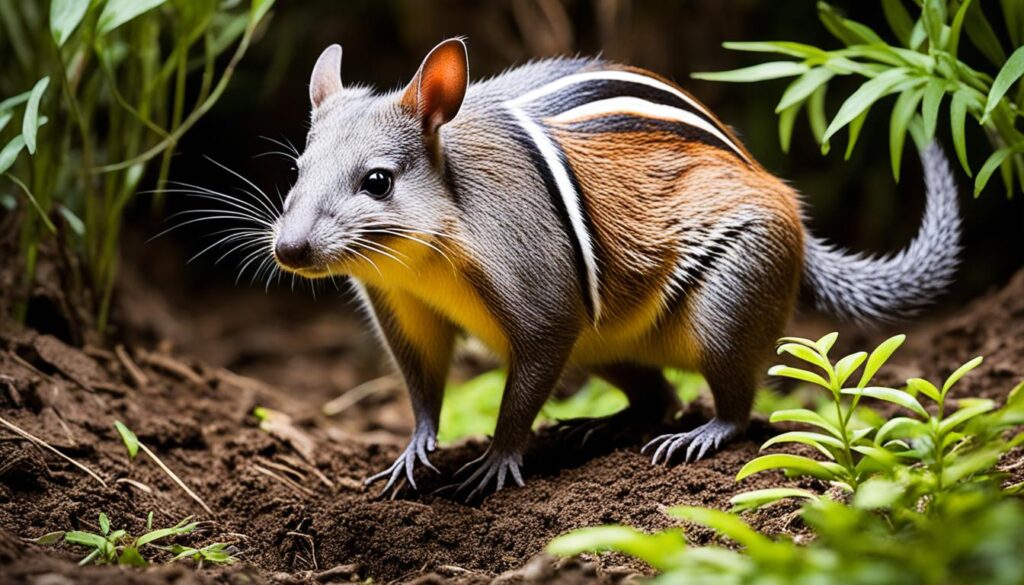
Whether it’s adapting to changes in their environment or ensuring the continuity of their population, Xenorhinos demonstrate their remarkable ability to adapt and thrive. Their rapid breeding cycle is a testament to the resilience and ingenuity of these incredible bandicoots.
Xenicidae (New Zealand Wrens)
New Zealand Wrens, scientifically known as Xenicidae, are a fascinating family of birds. Despite their small size, they captivate with their unique characteristics and behaviors. One remarkable trait of several species within this family is their inability to fly, making them among the rare flightless birds in the avian world.
These tiny wrens have adapted to their terrestrial lifestyle in the forests of New Zealand, where they navigate the dense undergrowth with agility and precision. Although flightlessness typically limits a bird’s range, New Zealand Wrens have overcome this restriction by evolving strong legs and wings that aid them in hopping and climbing. This adaptation allows them to thrive in their forest habitats and forage for food on the ground.
Despite their flightlessness, New Zealand Wrens are highly skilled climbers and acrobats. They gracefully navigate the intricate branches, using their sharp beaks to probe into crevices and extract insects. Their unique foraging techniques and feeding habits contribute to the ecological balance within their forest ecosystems.
“New Zealand Wrens are a testament to the incredible adaptability of birds. Despite their inability to fly, they have found success in their specialized terrestrial niche, demonstrating the remarkable diversity of avian evolution.” – Dr. Emily Thompson, Avian Biologist
While flightlessness may seem like a disadvantage, it has allowed New Zealand Wrens to develop other remarkable traits. Their wings have become modified into short, rounded structures, which aid in balance and maneuverability as they navigate the forest floor. Additionally, their feathers have evolved to provide excellent insulation, keeping them warm in the cool New Zealand climate.
The New Zealand Wrens, with their unique combination of flightlessness, agile terrestrial locomotion, and specialized adaptations, paint a vivid picture of the diversity and resilience of avian life. These captivating birds continue to intrigue scientists and bird enthusiasts alike, serving as a reminder that even in the most unexpected forms, nature never ceases to amaze.
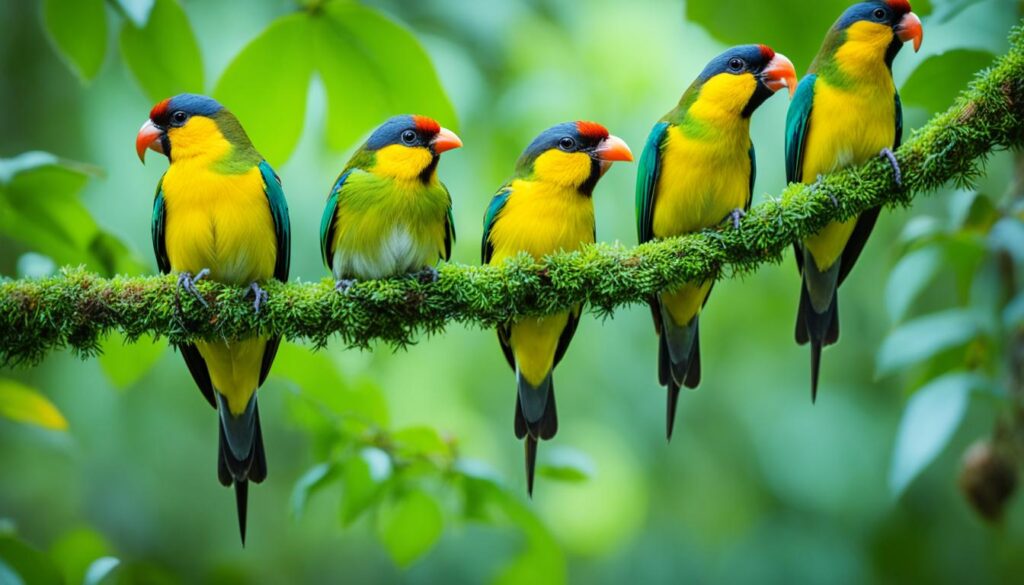
Comparison of Flightless Birds
| Bird Name | Habitat | Size | Unique Adaptations |
|---|---|---|---|
| Kakapo | New Zealand | Large | Strong legs for climbing, ability to inflate like a balloon |
| Kiwi | New Zealand | Small | Long beak for probing, reduced wings, excellent sense of smell |
| Apteryx | New Zealand | Small to Medium | Long bill for feeding on invertebrates, keen sense of hearing |
Xolmis (Flycatchers)
Xolmis birds belong to the flycatcher family and are known for their insect diet. They inhabit open habitats throughout South America and are recognized for their distinctive upright perching. These small, agile birds have evolved specialized hunting techniques to catch their prey in mid-air.
With their sharp eyesight and quick reflexes, xolmis flycatchers excel at capturing insects on the wing. They perch on branches, wires, and other elevated spots, patiently waiting for their next meal to pass by. Once they spot their target, they swiftly launch into flight, making acrobatic maneuvers to intercept the insect with precision and accuracy.
“Xolmis flycatchers are remarkable aerial predators. They have perfected the art of catching insects on the fly, showcasing their agility and speed.”
Their diet primarily consists of various flying insects such as flies, butterflies, moths, and beetles. By maintaining a purely insectivorous diet, xolmis birds play an essential role in regulating insect populations and maintaining the delicate balance of ecosystems.
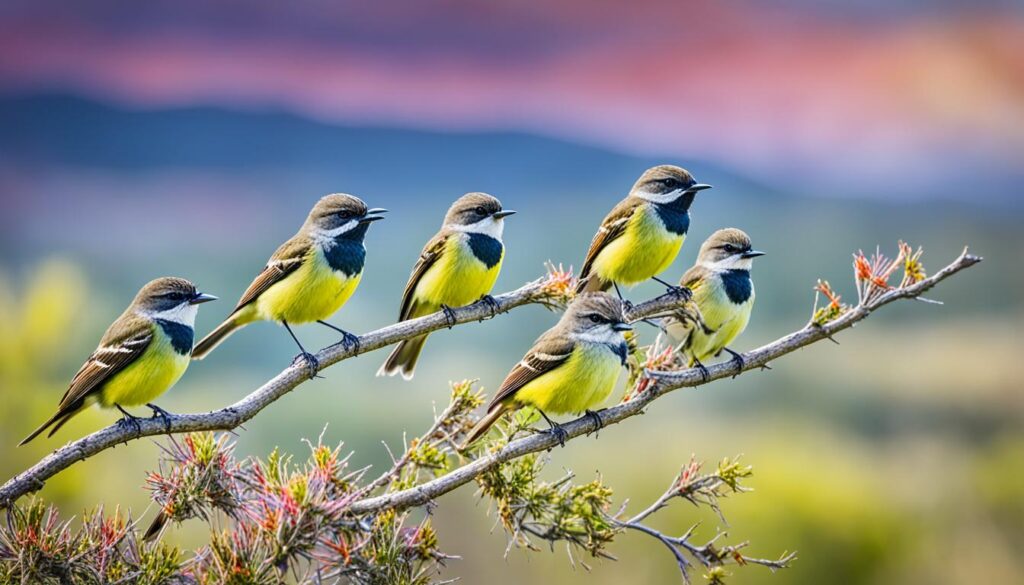
Characteristics of Xolmis Flycatchers
| Trait | Description |
|---|---|
| Distinctive Perching | Xolmis birds are known for their upright perching posture, which sets them apart from other flycatcher species. |
| Agile Flyers | These birds demonstrate remarkable agility in flight, performing rapid aerial maneuvers to catch their prey. |
| Insectivorous Diet | Xolmis flycatchers solely rely on insects as their primary source of nutrition, contributing to insect population control. |
| Camouflaged Plumage | Many xolmis species have cryptic plumage, blending in with their surroundings to avoid detection by predators. |
Overall, xolmis flycatchers showcase the incredible adaptability and specialized hunting techniques of birds that have evolved to thrive on an insect diet. Their presence in South American ecosystems impacts both the insect populations they rely on and the larger food web they are a part of.
Xiphias Gladius (Swordfish)
Xiphias Gladius, commonly known as the swordfish, is a large fish with a long, pointed bill resembling a sword. This iconic species is known for its impressive size, agility, and sword-like rostrum.
Although swordfish are often portrayed as one of the fastest fish in the ocean, their actual speeds are often exaggerated in popular media. While they are indeed swift swimmers, capable of reaching speeds of up to 50 miles per hour, they do not hold the title for the fastest swimming fish.
Despite not being the fastest, swordfish are still impressive in their abilities. They have a streamlined body shape and a large crescent-shaped tail fin that enables them to swiftly navigate through the open ocean waters. This design allows them to efficiently move through the water, making them adept predators.
Swordfish are highly migratory species, known to traverse long distances in search of food and suitable spawning grounds. Their diet primarily consists of smaller fish, squid, and crustaceans, which they capture by slashing their sword-like bill through the water. With their remarkable speed and agility, swordfish are skilled hunters capable of ambushing prey with precision.
Distinguishing Features of Swordfish:
- Distinctive sword-like bill, used for hunting and defense.
- Sleek, streamlined body shape for fast swimming.
- Crescent-shaped tail fin for efficient propulsion through the water.
- Grayish-blue coloration on the dorsal side and a silver-white underside.
“The swordfish’s unique bill and fast swimming abilities make it one of the most fascinating creatures in the ocean.” – Marine Biologist
Swordfish Conservation Status:
The conservation status of swordfish is currently classified as “Vulnerable” by the International Union for Conservation of Nature (IUCN). Overfishing has been a significant threat to their populations, primarily due to their high commercial value. Sustainable fishing practices and international regulations are crucial to ensuring the long-term survival of this majestic species.
Facts About Swordfish:
| Fact | Description |
|---|---|
| Speed | Swordfish can reach speeds of up to 50 miles per hour. |
| Size | Adult swordfish can grow up to 14 feet in length and weigh over 1,000 pounds. |
| Migrations | Swordfish undertake long-distance migrations in search of food and suitable breeding grounds. |
| Warm-Blooded | Swordfish are unique among fish species as they are partially endothermic, capable of maintaining their body temperatures higher than the surrounding water. |
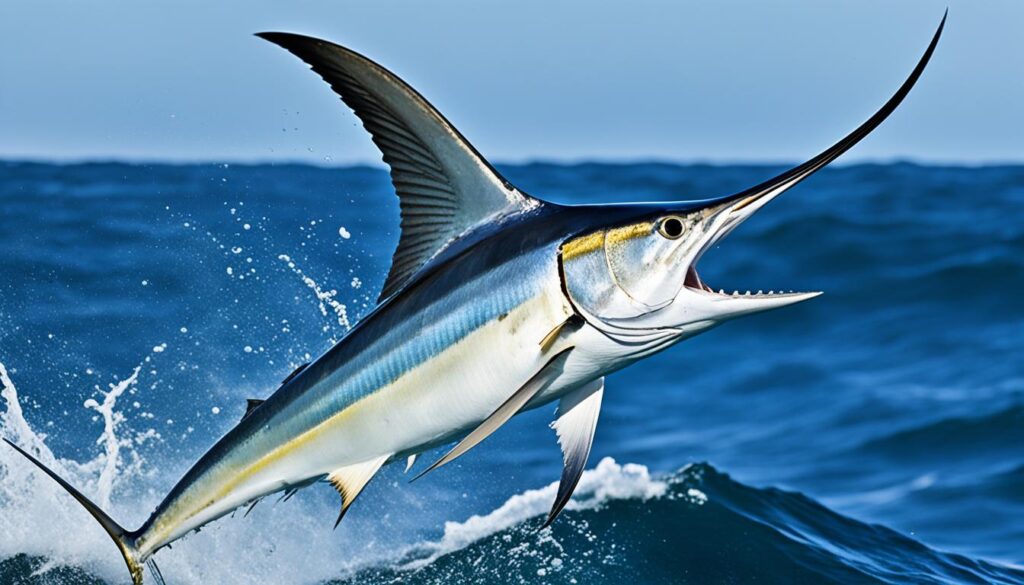
Conclusion
Although there are few animals that start with the letter X, they offer fascinating characteristics and adaptations that highlight the diversity of the natural world. From the transparent X-ray Tetra to the African ground squirrel Xerus, these unique creatures captivate our curiosity and inspire a deeper understanding of the variety of species across the globe.
Exploring animals that start with X not only introduces us to lesser-known species but also underscores the importance of biodiversity in our ecosystems. Each animal, like the xenops bird with its distinctive foraging behavior, contributes to the delicate balance of nature and plays a vital role in maintaining a healthy environment.
Whether it’s the genome sequencing of xenopus frogs or the specialized digestive system of the Arctic gull xeme, these animals offer valuable insights that contribute to scientific research and conservation efforts. They remind us of the intricate web of life and the interconnectedness of all living beings.










